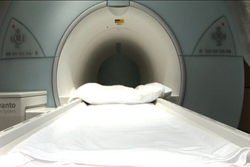 This is what the Magnetic Resonance Imaging (MRI) machine looks like at the Joe Buck Imaging Center in St. Louis Children's Hospital. It’s kind of big, isn’t it?
This is what the Magnetic Resonance Imaging (MRI) machine looks like at the Joe Buck Imaging Center in St. Louis Children's Hospital. It’s kind of big, isn’t it?
When you first get here, you will check in at the front desk and wait until your name is called. When it’s your turn, a staff person will take you and your family back to the room where your test will be done.
We offer 3T technology which uses one of the strongest magnets available. We pride ourselves in proactively ensuring the safety of our kids, families, and staff entering the magnetic field spaces. Since the MRI machine runs on a big magnet, everyone will need to take off anything metal that they’re wearing like jewelry, glasses and keys. You can expect to be asked screening questions as well as given safe clothing to wear while close to the magnet. Our MRI Technologists are experts in MRI safety so please feel free to ask your questions about safety measures.
Know Before You Go: Kids
What is an MRI?
An MRI is a big machine that takes pictures of the inside of your body, without even touching you! Doctors look at these pictures to see what is going on inside your body.
What will happen during my MRI?
A member of the care team will ask you your name and birth date then walk you and your caregiver back to the changing room. You will have to change into hospital pajamas and your caregiver will change into hospital scrubs.
When you go into the MRI room, you will see a large tunnel shaped camera. Some kids say it looks like a spaceship or a donut. For most MRI scans, you will have the option to watch a movie or listen to music. A helmet-like piece of equipment, called a coil, will go over your head; this is how you will see your movie.
When your MRI begins you will feel the table move slowly into the middle of the tunnel. Nothing inside the tunnel will touch you or hurt you. Once you’re comfortable, the technologist will need to leave the room to take your pictures. Don’t worry, you won’t be alone. You may hear the technologist talk to you through the headphones.
The MRI machine makes loud beeping and thumping noises when it takes your picture. The machine will not hurt you; this is just the sound of the camera at work! You will be given headphones to hear the movie and this will help to block out the noises of the machine.
What is my job?
Your job is to hold very still during your pictures and let the machine do all the work. If you move, the pictures will be blurry and the technologist might need to take them again.
Know Before You Go: Parents
Helpful Info
In most cases, one caregiver is able to be present in the MRI room with approval from a technologist. You and your child will need to remove all metal (including jewelry and glasses) and change into hospital pajamas or a gown. This is to ensure that all clothing material is safe to go into the MRI scanner. Scans can vary from 20 minutes to 2 hours in length.
Parent Role
You can help your child stay calm and relaxed by remaining calm yourself. If you are approved to go into the MRI room, you may be able to sit next to the bed with your hand resting on your child’s legs. This simple touch can comfort and reassure your child that he/she is not alone. It is natural for you to want to talk to your child during the scan; however, he/she will be unable to hear you due to the loud noises of the MRI. If your child is having a difficult time coping, the technologist can provide verbal reassurance through the headphones.
Important Notes
Depending on the type of scan your child is having, he/she may need contrast. Contrast is a medicine that makes the images clearer and is given through an IV. If you would like more specific information about your child’s scan or would like to speak to a child life specialist to discuss your child’s coping during this appointment, please call 314.454.6139. The technologist completing the exam can also page Child Life the day of your appointment for additional support.
Practice Tips
- Talk to your child about going to the hospital to get pictures taken of his/her body
- Have your child practice lying as still as a statue. Use a timer to see how long they can lay still; increase the time as your child is successful.
- Listen to MRI noises on YouTube












